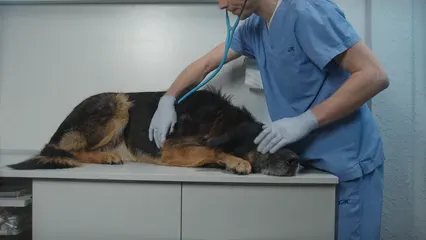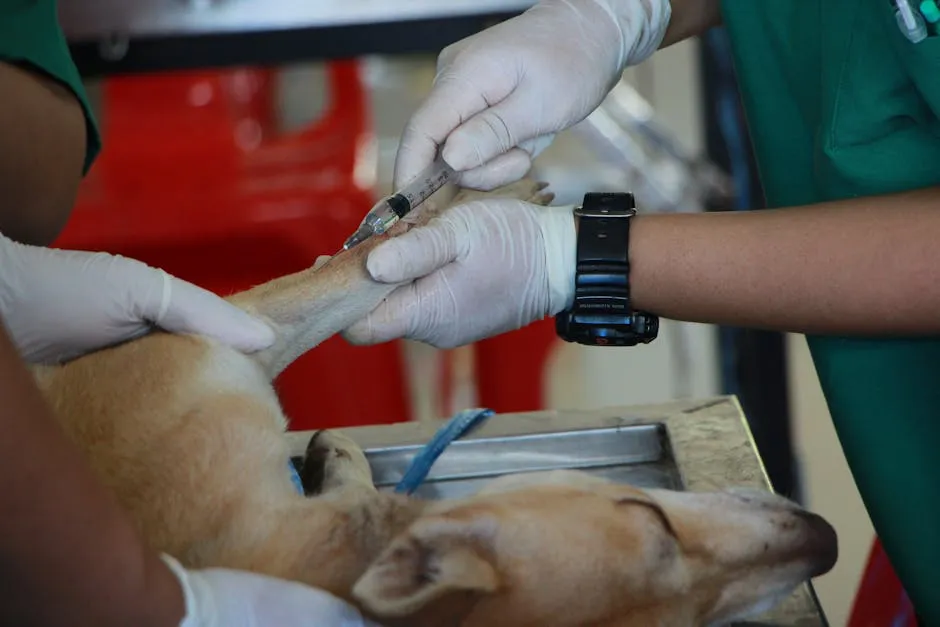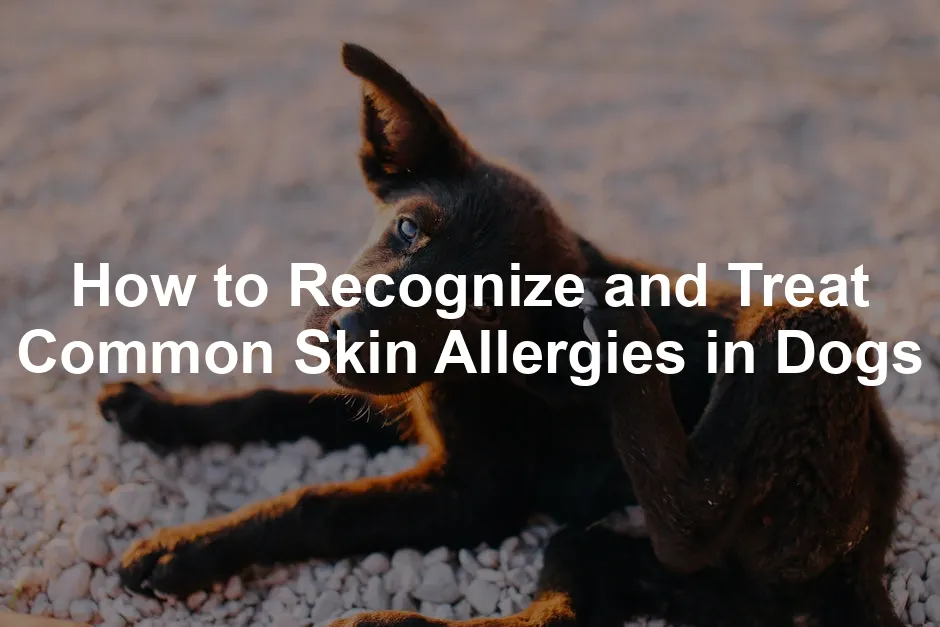Introduction
Skin allergies in dogs are more common than you might think. They can lead to discomfort and suffering for our furry friends. Dogs often display signs like excessive scratching, licking, or biting at their skin. These allergic reactions can stem from various sources, including food, environmental factors, and pesky fleas. Recognizing symptoms early is crucial for effective treatment. If you notice your pup constantly itching or developing skin irritations, it’s time to take action. Early detection can help prevent complications and make treatments more effective. This article will discuss the different types of skin allergies, including food allergies, environmental allergies, and flea allergies. Understanding these allergies will help you care for your dog better and ensure their comfort and well-being.
Understanding Skin Allergies in Dogs
What is a Skin Allergy?
Skin allergies occur when a dog’s immune system overreacts to specific substances called allergens. These allergens can be found in the environment, food, or even from flea saliva. When a dog comes into contact with an allergen, their immune system mistakenly identifies it as a threat. This triggers an inflammatory response that leads to itching, redness, and discomfort. The immune system plays a significant role here. In a healthy dog, it protects against infections and diseases. However, with allergies, it misfires, causing unnecessary reactions to substances that are otherwise harmless. Common allergens include pollen, dust mites, certain foods, and flea saliva. Understanding how these allergies work can empower pet owners to recognize and treat them effectively. Recognizing skin allergies in dogs can be a challenge. Symptoms may vary widely, and sometimes, the underlying cause can be elusive. If your dog starts showing signs of discomfort, don’t hesitate to consult with your veterinarian. They can help identify the specific allergen and recommend appropriate treatment options.
Common Types of Skin Allergies in Dogs
Dogs can suffer from several types of skin allergies. Each type has its unique triggers and symptoms. Understanding these can help you manage your pet’s discomfort effectively. Flea Allergy Dermatitis is a common issue, often caused by flea saliva. Even one bite can lead to intense itching and irritation. Affected dogs may develop rashes and lose hair, particularly near their tails. Food Allergies also play a significant role in canine skin issues. Dogs can be allergic to common ingredients like beef, chicken, or grains. Symptoms often include itchy skin, frequent ear infections, and gastrointestinal upset. To help manage these food allergies, consider switching to a high-quality dog food designed for sensitive stomachs. Environmental Allergies, also known as Atopic Dermatitis, stem from allergens like pollen, dust mites, and molds. Dogs with this condition may scratch, lick, or chew at their skin, especially during specific seasons. Finally, Contact Allergies arise from direct contact with irritants such as certain fabrics, cleaning products, or plants. These allergies can cause localized reactions, leading to redness and itching in the affected areas. Understanding these allergies allows pet owners to take proactive steps in addressing their dogs’ needs. If you’re looking for a product to help manage your dog’s skin issues, consider Vet’s Best Allergy Itch Relief Shampoo. It can help soothe irritated skin and provide some comfort.For more detailed information on how to recognize and treat common skin allergies in dogs, check out this article on skin allergies in dogs.

Symptoms of Skin Allergies in Dogs
General Symptoms
Skin allergies can manifest through various symptoms, affecting your dog’s comfort and well-being. One of the most common signs is itchy and inflamed skin. Your dog may scratch, lick, or bite at their skin excessively. This can lead to secondary issues like infections. Watch for redness, rashes, or hot spots. These irritated areas can appear anywhere on your dog’s body, often in spots where they tend to scratch or lick the most. Hair loss is another indicator of skin allergies. As dogs scratch and bite at itchy areas, they may lose patches of fur, revealing irritated skin beneath. Additionally, recurrent skin infections can occur, complicating the overall situation and requiring veterinary attention.
Behavioral Changes
Skin allergies can also impact your dog’s behavior. For instance, you may notice restlessness or irritability. Your furry friend might seem more anxious, especially during allergy flare-ups. A dog suffering from allergies may show decreased activity levels. If your usually playful pup seems sluggish or uninterested in walks, it could be due to discomfort. Finally, observe any changes in eating or sleeping habits. Dogs with skin allergies might lose their appetite or have trouble settling down at night, making it crucial to monitor these changes closely. Recognizing these symptoms early can lead to timely treatment and improved quality of life for your pet.
Diagnosing Skin Allergies
Vet Consultation
When you suspect your dog has skin allergies, consulting a veterinarian is crucial. They have the expertise to identify the problem and suggest the right course of action. During your visit, your vet will likely start with a thorough examination. They’ll check for visible signs of allergies, such as redness, swelling, or hair loss. Next, they’ll ask about your dog’s medical history. This includes any previous allergies, medications, and lifestyle changes. The vet may also perform tests to rule out other conditions. These tests could include skin scrapes or blood tests. If they suspect an allergy, they might suggest further allergy testing. This thorough approach ensures your dog gets the most effective treatment possible.
Allergy Testing
Once your vet suspects a skin allergy, they may recommend allergy testing. This helps pinpoint the specific allergens affecting your dog. There are a few common testing methods to consider. Blood Tests are commonly used. They measure the level of antibodies in your dog’s blood. This gives a good indication of what allergens may be causing the issue. Intradermal Skin Testing is another method. It involves injecting small amounts of allergens into your dog’s skin. The vet then observes the reaction. It’s often considered the gold standard for allergy testing since it provides detailed information. Lastly, some food allergies require elimination diets. This involves removing potential allergens from your dog’s diet for a specific period. After that, you gradually reintroduce them to identify the culprit. This process can take time but is often very effective.Treatment Options for Skin Allergies
General Treatment Approaches
Managing skin allergies in dogs involves a combination of strategies. Each dog’s treatment plan may differ based on the underlying cause. Here are some common approaches to consider. Lifestyle changes can make a big difference. Keeping your dog’s environment clean is essential. Regular vacuuming and washing bedding help minimize allergens. Grooming also plays a vital role. Regular brushing reduces loose hair and dander. It can help prevent allergens from accumulating in your home. To help with grooming, the Furminator Undercoat Deshedding Tool is a fantastic investment, especially for shedding seasons. Bathing your dog with a soothing, hypoallergenic shampoo can alleviate itching. This not only cleans the skin but also removes allergens. Aim for regular baths, especially during allergy season.
Medications
When your dog suffers from skin allergies, medications can be a game-changer. They help alleviate discomfort and restore your furry friend’s happiness. Here’s a quick overview of common medications prescribed by veterinarians: Antihistamines are often the first line of defense. These handy pills block histamines, reducing itching and inflammation. Popular options include diphenhydramine (Benadryl) and cetirizine (Zyrtec). While they work wonders for some dogs, they may not be as effective for others. Always consult your vet before starting any medication. Corticosteroids are another powerful option. These steroids can quickly reduce inflammation and itching. However, they come with potential side effects, especially if used long-term. Your vet may recommend short courses to help your dog feel better without compromising their health. Finally, there’s immunotherapy, often referred to as allergy shots. This treatment involves exposing your dog to small amounts of allergens over time, helping their immune system build tolerance. While it requires commitment and patience, many pet owners find this approach effective in the long run. Always follow your veterinarian’s guidance when it comes to medication. With the right treatment, your dog can enjoy a more comfortable life, free from the itchiness of allergies. If you’re looking to promote dental health as well, consider the Arm & Hammer Dog Dental Care Kit. It can help keep your pup’s teeth clean and fresh, complementing their overall health.
Dietary Management
Diet plays a crucial role in managing food allergies in dogs. If you suspect your pooch has a food allergy, switching to a hypoallergenic diet may provide relief. These specialized diets contain limited ingredients, which reduces the chances of triggering an allergic reaction. Look for options with novel protein sources like duck or fish, as these are less likely to cause issues. In addition to diet, consider incorporating nutritional supplements that promote skin health. Omega-3 fatty acids, for instance, can help reduce inflammation and improve skin condition. Supplements like Zesty Paws Omega 3 Salmon Fish Oil for Dogs can be beneficial. Always discuss dietary changes and supplements with your veterinarian to ensure they’re suitable for your dog’s specific needs. Monitoring your dog’s reactions to food is essential. Keep a journal of what they eat and any symptoms observed. This information can assist your vet in diagnosing food allergies and adjusting their diet accordingly. By paying attention to what goes into your dog’s bowl, you can help keep their skin healthy and irritation-free.
Alternative Treatments
If traditional treatments aren’t quite cutting it, consider exploring alternative therapies. Acupuncture is gaining popularity among dog owners. This ancient practice can help alleviate itching and inflammation by stimulating specific points on your dog’s body. Many pet owners swear by its effectiveness, especially when combined with conventional treatments. Herbal remedies also offer potential relief. Ingredients like calendula and chamomile can soothe irritated skin and reduce inflammation. Always consult with your veterinarian before trying any alternative treatments to ensure they’re safe for your dog.Managing Skin Allergies at Home
Skin allergies in dogs can be a hassle, but with a bit of effort, you can help manage their discomfort right at home. Start by keeping your home clean. Regularly vacuum carpets and wash your dog’s bedding to minimize allergens. Dusting surfaces and using air purifiers can also help reduce airborne irritants. If you’re looking for a way to keep the environment clean, consider Earth Rated Dog Poop Bags for easy clean-up during walks. Monitor your dog’s outdoor exposure. During high pollen seasons, limit walks or plan outings during cooler times of the day. After outdoor activities, wipe your dog’s paws and coat to remove potential allergens. This simple routine can make a significant difference in their comfort levels.
When to Seek Veterinary Help
Not all scratching is created equal. While occasional itches are normal, persistent or worsening symptoms signal a need for veterinary attention. If your dog shows signs of severe discomfort, don’t wait for things to get worse. Watch for these red flags: excessive scratching, licking, or biting at their skin. If you notice inflamed or broken skin, it’s time to call in the professionals. Secondary infections can develop when dogs incessantly scratch, turning a minor issue into a major problem. Other signs to keep an eye on include hot spots, hair loss, or changes in behavior. If your pup seems more irritable or restless than usual, allergies could be the culprit. Gastrointestinal symptoms like vomiting or diarrhea, particularly after eating, may also indicate food allergies. Lastly, if you see any swelling, especially around the face or mouth, don’t wait! This could signify an allergic reaction requiring immediate veterinary intervention. Remember, your dog’s well-being is a priority, so when in doubt, seek help. A quick visit to your vet can lead to a tailored treatment plan, easing your dog’s suffering swiftly.
FAQs
Can all dogs develop skin allergies?
Yes, any dog can develop skin allergies, but some breeds are more prone. Common predisposed breeds include Golden Retrievers, Dalmatians, and Terriers. Age also plays a role; allergies often appear between 1 and 3 years but can develop at any time.
What are the best diets for dogs with food allergies?
Hypoallergenic diets are often recommended for dogs with food allergies. These diets contain unique protein sources and limited ingredients to minimize allergic reactions. Consult your vet for specific product recommendations tailored to your dog’s needs.
How can I tell if my dog has fleas?
Flea infestations can be tricky to spot. Look for excessive scratching, biting, or licking around the tail and hindquarters. You may also notice flea dirt—small black specks in your dog’s fur. If in doubt, a thorough grooming session or a vet check can help confirm their presence.
Are skin allergies in dogs curable?
Skin allergies in dogs are often chronic. While there’s no cure, effective management strategies can help minimize symptoms. Consult your veterinarian for tailored treatment plans that may include medications, diet changes, or environmental management.
What can I do at home to help my dog with allergies?
There are several home remedies to support your dog’s comfort. Regular grooming can help remove allergens from their coat. Bathing with hypoallergenic shampoos can soothe irritated skin. Additionally, maintaining a clean environment and monitoring outdoor exposure during high allergen seasons can make a significant difference. Always consult your vet before trying new treatments.

Conclusion
Recognizing and treating skin allergies in dogs is essential for their health and happiness. Allergies can lead to discomfort, but with prompt recognition and action, you can minimize their impact. Early detection is key. Monitoring your dog’s behavior and symptoms can help catch issues before they escalate. Consulting your veterinarian provides tailored advice and treatment options. Your vet can help identify the specific allergens affecting your dog, guiding you to effective management strategies. Proactive management is crucial for improving your dog’s quality of life. Regular check-ups and a keen eye on any changes can make all the difference. Remember, your furry friend relies on you to advocate for their comfort. Together with your veterinarian, you can ensure they remain happy, healthy, and itch-free. If you’re considering new toys to keep your dog entertained while managing their allergies, look into the Dog Puzzle Toy. It can provide mental stimulation and keep your pup engaged.Please let us know what you think about our content by leaving a comment down below!
Thank you for reading till here 🙂
All images from Pexels





